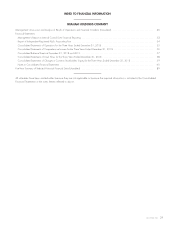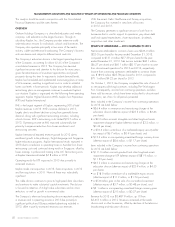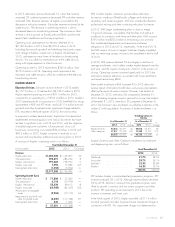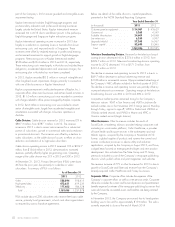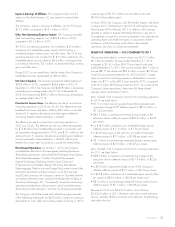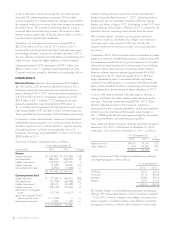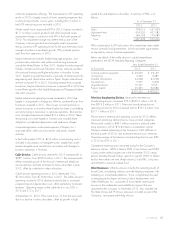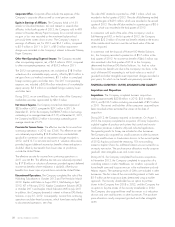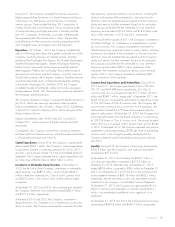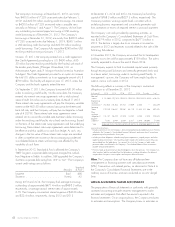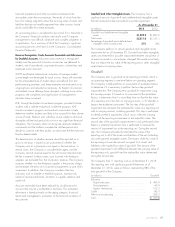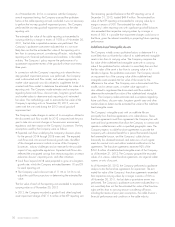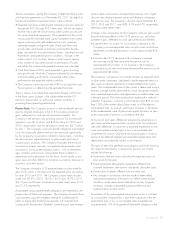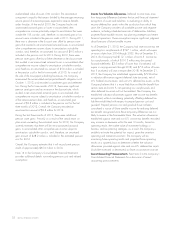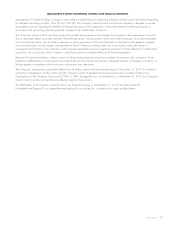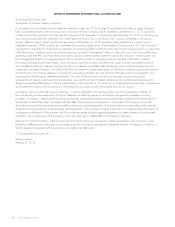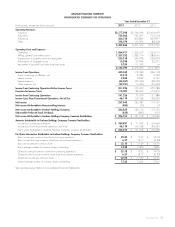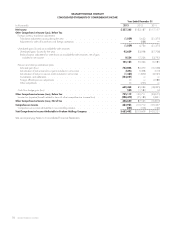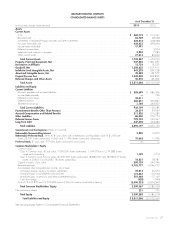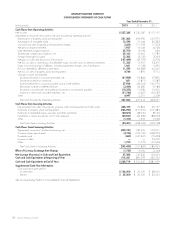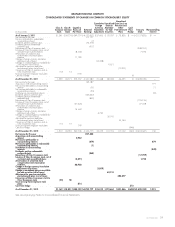Washington Post 2013 Annual Report Download - page 67
Download and view the complete annual report
Please find page 67 of the 2013 Washington Post annual report below. You can navigate through the pages in the report by either clicking on the pages listed below, or by using the keyword search tool below to find specific information within the annual report.
historical experience and other assumptions believed to be
reasonable under the circumstances, the results of which form the
basis for making judgments about the carrying value of assets and
liabilities that are not readily apparent from other sources. Actual
results could differ from these estimates.
An accounting policy is considered to be critical if it is important to
the Company’s financial condition and results and if it requires
management’s most difficult, subjective and complex judgments in
its application. For a summary of all of the Company’s significant
accounting policies, see Note 2 to the Company’s Consolidated
Financial Statements.
Revenue Recognition, Trade Accounts Receivable and Allowance
for Doubtful Accounts. Education tuition revenue is recognized
ratably over the period of instruction as services are delivered to
students, net of any refunds, corporate discounts, scholarships and
employee tuition discounts.
At KTP and Kaplan International, estimates of average student
course length are developed for each course, along with estimates
for the anticipated level of student drops and refunds from test
performance guarantees, and these estimates are evaluated on an
ongoing basis and adjusted as necessary. As Kaplan’s businesses
and related course offerings have changed, including more online
programs, the complexity and significance of management’s
estimates have increased.
KHE, through the Kaplan Commitment program, provides first-time
students with a risk-free trial period. Under the program, KHE
monitors academic progress and conducts assessments to help
determine whether students are likely to be successful in their chosen
course of study. Students who withdraw or are subject to dismissal
during the risk-free trial period do not incur any significant financial
obligation. The Company does not recognize revenues related to
coursework until the students complete the risk-free period and
decide to continue with their studies, at which time the fees become
fixed or determinable.
The determination of whether revenue should be reported on a
gross or net basis is based on an assessment of whether the
Company acts as a principal or an agent in the transaction. In
certain cases, the Company is considered the agent, and the
Company records revenue equal to the net amount retained when
the fee is earned. In these cases, costs incurred with third-party
suppliers are excluded from the Company’s revenue. The Company
assesses whether it or the third-party supplier is the primary obligor
and evaluates the terms of its customer arrangements as part of this
assessment. In addition, the Company considers other key
indicators such as latitude in establishing price, inventory risk,
nature of services performed, discretion in supplier selection and
credit risk.
Accounts receivable have been reduced by an allowance for
amounts that may be uncollectible in the future. This estimated
allowance is based primarily on the aging category, historical
trends and management’s evaluation of the financial condition of
the customer.
Goodwill and Other Intangible Assets. The Company has a
significant amount of goodwill and indefinite-lived intangible assets
that are reviewed at least annually for possible impairment.
As of December 31
(in millions) 2013 2012
Goodwill and indefinite-lived intangible
assets .......................... $1,829.9 $1,857.6
Total assets ........................ $5,811.0 $5,105.1
Percentage of goodwill and indefinite-lived
intangible assets to total assets ........ 31% 36%
The Company performs its annual goodwill and intangible assets
impairment test as of November 30. Goodwill and other intangible
assets are reviewed for possible impairment between annual tests if
an event occurred or circumstances changed that would more likely
than not reduce the fair value of the reporting unit or other intangible
assets below its carrying value.
Goodwill
The Company tests its goodwill at the reporting unit level, which is
an operating segment or one level below an operating segment.
The Company initially performs an assessment of qualitative factors
to determine if it is necessary to perform the two-step goodwill
impairment test. The Company tests goodwill for impairment using
the two-step process if, based on its assessment of the qualitative
factors, it determines that it is more likely than not that the fair value
of a reporting unit is less than its carrying amount, or if it decides to
bypass the qualitative assessment. The first step of the goodwill
impairment test compares the estimated fair value of a reporting unit
with its carrying amount, including goodwill. This step is performed
to identify potential impairment, which occurs when the carrying
amount of the reporting unit exceeds its estimated fair value. The
second step of the goodwill impairment test is only performed when
there is a potential impairment and is performed to measure the
amount of impairment loss at the reporting unit. During the second
step, the Company allocates the estimated fair value of the
reporting unit to all of the assets and liabilities of the unit (including
any unrecognized intangible assets). The excess of the fair value of
the reporting unit over the amounts assigned to its assets and
liabilities is the implied fair value of goodwill. The amount of the
goodwill impairment is the difference between the carrying value of
the reporting unit’s goodwill and the implied fair value determined
during the second step.
The Company had 11 reporting units as of December 31, 2013.
The reporting units with significant goodwill balances as of
December 31, 2013, were as follows, representing 98% of the
total goodwill of the Company:
(in millions) Goodwill
Education
Higher education ............................ $ 409.0
Test preparation ............................. 49.9
Kaplan international .......................... 512.2
Cable ...................................... 85.5
Television broadcasting ......................... 203.2
Total ....................................... $1,259.8
2013 FORM 10-K 49


